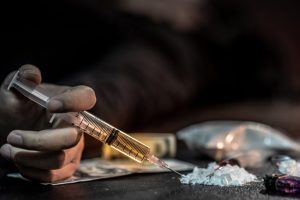The United States and much of the world is currently suffering from an opioid epidemic. In 2018 alone, over 67,000 people died of a drug overdose. More than 70% of these deaths involved either an illicit opioid or a prescription opioid. While the illegal drug heroin continues to play a significant role in the opioid crisis, the current spike in drug overdoses can be largely attributed to fentanyl, fentanyl analogues, and other similar synthetic opioids.
It may come as a surprise that fentanyl is actually a perfectly legal medicine. In thinking about the dangers of drugs and the opioid epidemic, it is not helpful to think of legal prescription medications as somehow “safer” than illicit drugs. The fact is, all opioids are dangerous, no matter what purpose manufacturers had in mind when producing the drugs. The most important factor that determines an opioid’s effect is its potency.

On This Page:
Opioid Potency
The potency of opioids is generally measured by comparing drugs with morphine. All opioid drugs, with the exception of fully synthetic opioids, are derived from the opium poppy. Morphine happens to the opioid compound that is most abundant in the opium poppy. It is one of the first opioids derived directly from the poppy, and it continues to play an important role in medical settings. Morphine is also used to produce over 250 other derivative drugs, including codeine, hydromorphone, oxymorphone, and heroin. As such, morphine is generally the standard by why other opioids are judged.
Morphine, like other opioids, is primarily used as an analgesic to treat pain. Morphine is a powerful analgesic. It is used in hospital settings to treat pain arising from surgery, childbirth, 3rd degree burns, and heart attacks. To understand how potent fentanyl is, it need only be said that fentanyl is 50-100 times stronger than morphine.
A number of fentanyl analogues exist on the market as well that are significantly stronger than this. Carfentanil that is often sold illicitly on the streets is estimated to be 10,000 times more powerful than morphine. While street drugs like heroin are infamous for their potency, fentanyl is at least 50 times more potent than heroin, and many fentanyl analogues make heroin seem about as strong as chamomile tea in comparison.
What is Fentanyl Used For?
Fentanyl’s high potency makes it a very useful drug in certain unique medical situations. Fentanyl can be used to treat severe and chronic pain that does not respond well to weaker medications. It is most commonly used to help cancer patients handle the pain associated with chemotherapy, but it is also sometimes utilized for invasive surgeries, medical emergencies, and severe back pain.
Prescription fentanyl can be taken using two different routes of administration. Several formulations of fentanyl can be dissolved sublingually under the tongue or against the cheek. These formulations include fentanyl pills, fentanyl tablets, and the fentanyl lollipop. More commonly, however, fentanyl is taken transdermally via the fentanyl patch.
The fentanyl transdermal patch is applied to the skinn for 24 hour periods and delivers a steady dosage that is spread out over a long period of time. The patch is helpful for chronic pain, and it also mitigates the dangers associated with taking such a potent opioid all at once. Doctors generally prescribe fentanyl only when absolutely necessary and under careful medical supervision.
Nonetheless, even legitimately prescribed fentanyl poses a vast number of dangers due to the drug’s potency. All opioids lead to physical dependency, but the strength of fentanyl makes physical dependency all but inevitable if taken for longer than a short period. When individuals become dependent on fentanyl, they experience severe and debilitating withdrawal symptoms when they stop.
Fentanyl withdrawal is often more severe than the pain that the drug was initially prescribed to treat. As such, prescription fentanyl misuse, abuse, and even taking it as prescribed can rapidly lead to addiction, which can wreck lives and ultimately lead to life-threatening overdoses.
Dangers of Fentanyl Abuse
While fentanyl is rarely specifically sought out as a recreational drug, prescription opioid use is one of the most common routes to opioid addiction more broadly. 21% to 29% of people who are prescribed prescription opioids misuse them, and 8% to 12% develop an opioid use disorder. 80% of heroin users began to use opioids initially in the form of prescription opioids. As such, fentanyl’s potency can rapidly lead people down a long-term path of opioid abuse.
Even people who do not intend to use fentanyl are at a high risk. Fentanyl is frequently added to other drugs, including heroin, methamphetamine, and cocaine. When altered or manufactured for illicit use, fentanyl is visually indistinguishable from heroin and can be mixed with it to increase the drug’s potency. Drug dealers often sell products that contain fentanyl to unwitting drug users.
Side Effects of Fentanyl
Opioid overdoses occur when people take higher doses of opioids than their bodies have a tolerance for; while regular heroin users may believe they are using heroin “safely” by taking their regular accustomed dose, when fentanyl is combined with heroin, the potency may be beyond what they can handle. The dangers are further compounded when fentanyl is combined with stimulants like methamphetamine or cocaine.
Since fentanyl is a central nervous system depressant that shuts down the body and stimulants put a high demand on the body, the drug interaction can rapidly lead to a life-threatening overdose. While some users combine these drugs deliberately in a practice known as speedballing, the vast majority of fentanyl overdose deaths occur among people who had no intention of using fentanyl.
Getting Help
Fentanyl may be powerful, but the effects of an overdose can actually be reversed by administering an opioid antagonist known as naloxone. Naloxone, which is sold under the brand name Narcan, can be sprayed in the nostril of a person who is overdosing to reverse their overdose and send them into immediate withdrawal.
Administering naloxone rapidly can save a person’s life. However, because fentanyl is so powerful, it remains in the body long after naloxone has worn off, which means a person may begin overdosing again hours after being saved by naloxone. For that reason, it is essential that anyone experiencing a fentanyl overdose be given immediate medical care.
After detoxing and receiving medical care, it is crucial to have a long-term plan for maintaining sobriety. Design for Recovery, a structured sober living in Long Angeles County, offers a comprehensive recovery program for young men suffering from opioid use disorders. Residents work together to understand themselves and their addictions while working to develop the skills and coping tools they need to maintain long-term sobriety.
However, maintaining sobriety and avoiding relapse is only half the battle: at Design for Recovery, residents repair the damage of addiction and work to build better lives for themselves. Fentanyl may be powerful, but no matter how severe a person’s addiction is, recovery is possible. If you or a loved one suffers from fentanyl addiction or any other substance use disorder, contact us today.
Share this :
Fentanyl Related Resource

























